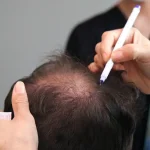Hair loss affects millions of people across the world, but the good news is that modern medicine now offers more than one effective solution. Two of the most popular treatments today are PRP (Platelet-Rich Plasma) therapy and Hair Transplantation. Both approaches have proven results — yet they work in very different ways.
Choosing between them depends on your hair loss stage, scalp health, expectations, and lifestyle. Understanding how each treatment functions, what it can realistically achieve, and who it’s best suited for can help you make a confident and informed decision.
The Basics – How PRP and Hair Transplants Differ
PRP therapy is a non-surgical, regenerative procedure that uses your own blood’s platelets to stimulate dormant hair follicles. It enhances natural growth by improving blood flow and delivering growth factors directly to the scalp.
Hair transplantation, on the other hand, is a surgical procedure that involves moving healthy hair follicles from a donor area (usually the back or sides of the head) to thinning or bald regions. These transplanted follicles are genetically resistant to hair loss and grow permanently in their new location.
In essence, PRP revitalises what you already have, while a transplant replaces what’s been lost.
How PRP Therapy Works
The process begins with a small blood draw from the patient. This sample is then spun in a centrifuge to separate plasma rich in platelets – the body’s natural healing agents. This PRP solution is injected into the scalp at precise points around thinning areas.
Platelets contain growth factors such as PDGF, VEGF, and EGF that:
- Stimulate stem cells within hair follicles.
- Improve blood circulation in the scalp.
- Extend the hair’s growth (anagen) phase.
Over multiple sessions, PRP helps strengthen existing hair, reduce shedding, and promote thicker regrowth.
The treatment is ideal for early to moderate thinning, especially when the follicles are still active but weakened.
How Hair Transplants Work
A hair transplant involves the surgical relocation of follicles from donor areas (where hair is resistant to DHT) to regions with thinning or baldness. The two primary techniques are:
- FUE (Follicular Unit Extraction): Individual follicles are extracted and implanted one by one.
- FUT (Follicular Unit Transplantation): A strip of scalp is removed, and follicles are separated microscopically before implantation.
The transplanted follicles behave exactly as they did in the donor site – growing permanently and naturally. This makes it a long-term solution for pattern baldness and advanced hair loss.
The best hair transplant clinics employ advanced FUE methods, combining surgical precision with natural design aesthetics for seamless, life-like results.
PRP vs. Transplant – Comparing the Two
While both PRP therapy and hair transplants aim to restore hair growth, they differ significantly in their approach, duration, and long-term impact. PRP therapy is entirely non-surgical, making it ideal for individuals with early to moderate thinning who prefer a minimally invasive solution. The recovery time is minimal – most patients resume their daily routine the same day – and improvements appear gradually over three to six months as growth factors rejuvenate the follicles. Because PRP enhances existing hair rather than replacing it, maintenance sessions are typically required to sustain long-term results.
In contrast, a hair transplant is a surgical solution designed for more advanced baldness. It offers permanent results by relocating healthy, DHT-resistant follicles to thinning areas. The procedure requires about five to ten days of recovery, and visible regrowth usually begins within four to six months. While the upfront cost is higher than PRP, a transplant provides enduring value and natural coverage that doesn’t require ongoing touch-ups.
Ultimately, both treatments can complement each other beautifully – many patients choose PRP sessions after a transplant to boost healing, improve graft survival, and enhance overall density for more complete, lasting results.
Who Should Choose PRP?
PRP therapy is best suited for:
- Men and women in the early stages of hair thinning.
- Individuals with diffuse shedding due to stress, nutrition, or hormones.
- Those who want a non-invasive option without surgery.
It’s particularly effective when follicles are still alive but underactive. For example, those experiencing post-partum shedding, stress-related loss, or telogen effluvium can see remarkable results from PRP alone.
However, PRP may not restore areas that have completely lost follicles – in such cases, it serves as a supporting therapy.
Who Should Choose a Hair Transplant?
A hair transplant is the right choice for:
- Individuals with visible bald patches or receding hairlines.
- Men with advanced androgenetic alopecia (male pattern baldness).
- Those seeking permanent, high-density coverage.
It’s also recommended for patients who have already tried medications or PRP but want a more definitive result. When done by skilled professionals, transplants recreate natural-looking density that lasts for decades.
Can You Combine Both?
Absolutely; in fact, combining PRP and transplant is one of the most effective strategies for optimal outcomes.
Here’s how:
- Pre-Transplant PRP strengthens donor follicles.
- During Surgery, PRP is sometimes used to hydrate grafts and improve viability.
- Post-Transplant PRP accelerates healing, reduces inflammation, and enhances new growth.
At Bloom Hair Transplant, this dual approach is frequently used to maximise graft survival rates and promote thicker, healthier regrowth across the scalp.
Cost, Maintenance, and Expectations
While PRP requires multiple sessions (usually every 3–4 weeks for 3–6 sessions), a transplant is typically a one-time investment with permanent results.
PRP’s lower cost and non-invasive nature make it attractive for early-stage patients, whereas transplants provide unmatched value for those seeking permanent density.
Realistic expectations are essential for both – PRP enhances what exists; transplants replace what’s gone. Results depend on factors like age, scalp health, genetics, and aftercare discipline.
The Healing Process
PRP recovery is almost immediate, with minor soreness that subsides within a day. Hair transplants, meanwhile, involve a short recovery window where mild swelling or redness may occur for up to a week.
Within a few months, new follicles from a transplant begin to grow naturally — blending perfectly with existing hair and requiring no special maintenance beyond normal care.
Personalised Solutions, Proven Results
There’s no one-size-fits-all answer in hair restoration. PRP and hair transplants each serve different purposes – one revitalises, the other reconstructs.
For mild to moderate hair loss, PRP is an excellent first step to awaken dormant follicles. For those with advanced thinning or bald patches, transplants offer the only permanent solution.
By consulting experienced specialists who combine both treatments strategically, you can restore not just your hair, but your confidence. Because the right choice isn’t about what’s trendy; it’s about what truly works for you.





